Connecting an electric heated towel rail: step-by-step installation instructions
Ease of installation and aesthetics have shifted consumer choice towards easy-to-use electrical heated towel rail. But its self-installation does not boil down to simply fixing the equipment with 4-8 screws.
Therefore, we will figure out how to properly connect the electrical heated towel rail (EPS) in the bathroom.
The content of the article:
What is the value of modern heated towel rails?
Towel warmers have become a great boon for residents of high-rise buildings for many reasons.
The electrical basis of this equipment avoids the complexity of installation and repair. Water heated towel rails they require a separate riser in the bathroom niche, which in old houses has long been rusted and almost rotted in cemented floors.
Residents save time by applying to Housing office to stop the flow of coolant when repairing leaked water devices.
Aesthetics and hygiene EPS obvious. There are hundreds of models of this equipment that will allow you to choose the necessary size, desired appearance and convenient functionality - read more about the features of the choice Further.
No need to paint the pipes, clean the seams and be careful not to spoil the fabric. In addition, an impractical piping, which often extends through two walls, is excluded from the wiring diagram.
The ability to use adjusting devices has lifted the functionality of electroappliances to heaven. Can choose EPS with timer, temperature adjustable, backlit, with shelves. Although to save money, you can heated towel rail plug into an outlet with an integrated timer.
Mount heated towel rails on rotary axes to rotate the frame in the right direction is also a useful development of the engineering idea.
Electrical equipment allows for controlled heating of the bathrooms. In apartment buildings with individual heating, the bathroom is often a dead end in the heating distribution: pipes are allowed into the bathroom through the kitchen, which is loaded with communications.
Autonomous application heated towel rail It helps in the bathroom to remove unnecessary heating communications, in the kitchen to simplify the situation and increase ergonomics, improves the appearance of the room and significantly simplifies cleaning.
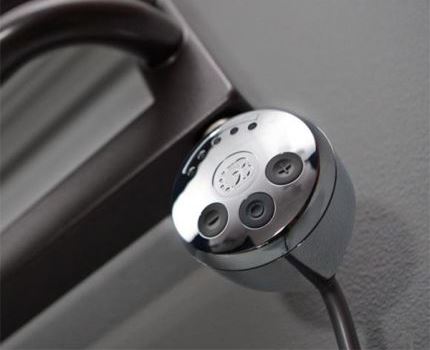
Electric heated towel rails with dignity do their main job - drying towels and clothes. Chrome pipes will never harm or leave marks even on delicate fabrics.
We can further list the advantages of electric heated towel rail, but it’s better to install it in your bathroom and feel all the benefits yourself. The psychological effect of the installation EPS comparable to installing a modern washing machine after many years of hand washing!
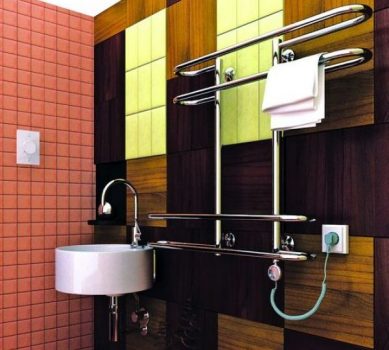
Operation without installation - reality
If you do not take into account additional options, then heated towel rails in appearance they are simply metal tubes welded into the frame with an electric cable emerging from them, so people often choose EPSfocusing only on its design look.
Manufacturing companies take into account this marketing nuance and try to offer consumers original engineering ideas.
The result of one of these ideas was heated towel rail. It does not require installation at all, to turn it on, just plug the device cord into a power outlet. This option is suitable for bathrooms with a large area and a permanent dry floor area, where the device can fit without interference.
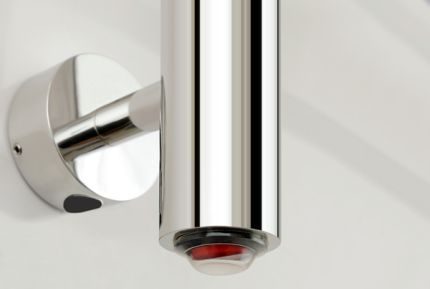
Mounted electric heated towel rails also have mounting features. Some models are equipped with an electric cable, which is built into one of the wall mounts. Such heated towel rails It is advisable to install before laying tiles in the bathroom.
Installing the appliance in the bathroom
There are three mounting options for electrical heated towel rails:
- Floor installation EPS.
- Installation of equipment before laying wall tiles.
- Connection heated towel rail on the laid tile.
Before instrumental installation work, you must first determine the installation location EPS in accordance with simple rules.
Device Location Rules
AT Khrushchev the place for heated towel rail no choice due to the geometrical limitations of space. But in private houses and modern apartments with large bathrooms, it is advisable to take into account the following rules when installing EPS. The main criterion when choosing a place is its moisture resistance.
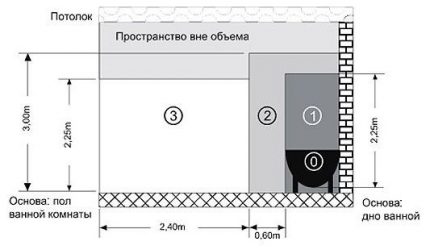
The described rules are not a whim of some author, but are created for the safety of people during the operation of heating electric equipment.
Connection EPS to the network
If the bathroom already has all the interior decoration, and you are not going to change anything, then in this case heated towel rails preferably closer to the power source.

Replacement power cable to a longer version or its extension by creating bows will result in loss of warranty service on the device.
Therefore, the options for connecting electrical heated towel rail when the outlet is remote, you can offer a little:
- Buy floor heated towel rail, which can be placed closer to the outlet if necessary.
- Install additional waterproof outlet near EPSby pulling the cable in the box from the existing power point. This option is the least aesthetic and unsafe option.
- If there are removable ceiling panels, you can stretch the cable from the ceiling lighting by installing an additional outlet under the ceiling above heated towel rail.
- Lengthen power cableby canceling a free warranty service.
- Stash gently wall from an existing electrified point and install an additional moisture-proof outlet recessed into the wall.
Although electricity consumption EPS rarely exceeds half a kilowatt, the socket for its connection must have a sufficient supply of power and be waterproof. In case of careless handling of the shower head, water can get on the electrical contacts and there will be a short circuit with fire.
Therefore, use only waterproof, certified electrical equipment in the bathroom.
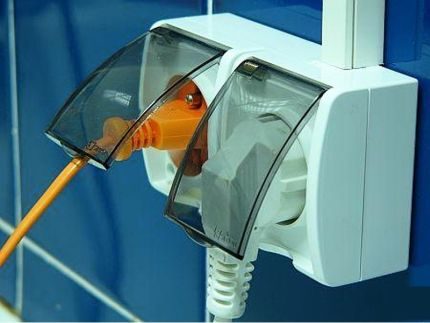
The introduction of the latest technologies in the field of material physics makes the application appliances absolutely safe even at a voltage of 220 V. New dielectric materials and innovative engineering methods of insulation guarantee the absence of inducing currents in the housing while maintaining its high thermal conductivity.
But do not neglect the installation of protective equipment, because its operation is designed specifically for cases of breakdown of electrical appliances and violation of their insulation.
Installation of wiring in the bathroom
If installation heated towel rail coincides or precedes the laying of tiles in the bathroom, you should pay attention to the rules for laying cables and installation power outlets in wet rooms.
Consider the installation recommendations for installing electrical wiring in the bathroom:
- the power line must be grounded;
- all elements of the wiring must be waterproof;
- separate outlets must be installed on sockets and fixtures (RCD), which will turn off the power in case of current leaks;
- it is advisable to choose copper wires with a non-combustible winding;
- be sure to use a three-core cable to ground all electrical appliances.
To lay the cable to the planned outlet, you first need to make the grinder a strob (groove) for the wire.
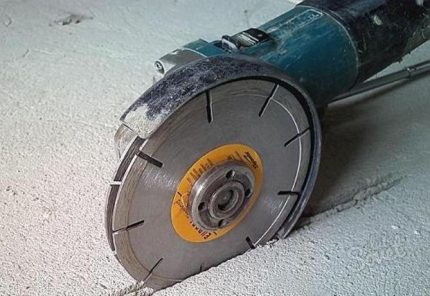
Then a drill with a special nozzle in the wall makes a recess for the outlet.
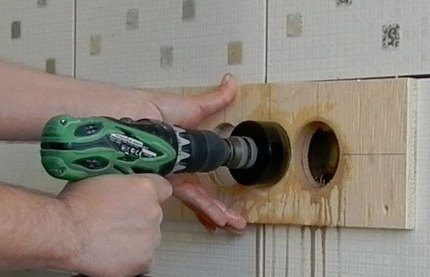
Then a cable is laid in the strobe, which is pressed by special clamps or simply fixed every 15-20 cm with cement mortar. After that put undergrowth and the waterproof socket itself is mounted. More detailed instructions on installing outlets in the bathroom can be found in this stuff.
When installing electrical heated towel rail with a hidden input, installation of a socket is not required. It is enough to leave the “tail” of the electric wire measuring 10-15 cm in the right place.
If you have already bought an electric heated towel rail and if you have a power outlet in a convenient place, then it's time to move on to the step of attaching the equipment to the wall.
How to drill holes in a tile?
Having completed all measurements and marking with a marker the points for screwing in the fixing EPS screws, drill holes for installation dowels.
We will reveal some secrets of the correct and safe drilling of tiles:
- it is not recommended to drill holes near the edges of the tile and in the tile spaces;
- to avoid overheating of the drill, you can periodically dip it in a glass of clean water;
- if drilling is carried out with a perforating drill, then first the tile is drilled on the hammerless mode, and then drill in the punch mode;
Note that when drilling tiles at low speeds, the use of a drill for metal is allowed.
The procedure for drilling a hole in a tile is as follows:
- Marker points on the tile.
- Gently enamel enamel at the intended point using a drill at low speeds or the tip of a file.
- If the enamel cannot be beaten, then a piece of adhesive tape can be glued to the drilling site so that the drill does not slip.
- Drill a tile in shockless mode.
- Drill the wall in punch mode with maximum pressure.
After the formation of all holes, plastic is pushed into or hammered into them with a soft mallet. dowels.
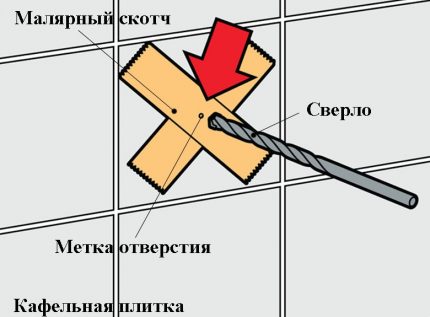
For each type of wall, appropriate fasteners are used for a more secure fit. heated towel rails.
It is possible to use all the options shown in the figure.
Direct installation heated towel rail on the wall
Install electrical heated towel rail on the wall is better with an assistant. You can do this yourself, but it is better for one person to hold the device, and the second screw it to the wall with screws.
Between the vertical wall and the legs EPS do not forget to put the rubber or plastic seals that come with heated towel rail.
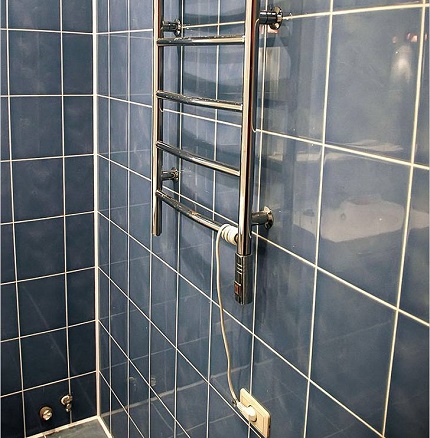
Hang heated towel rail necessary only after disconnecting it from the mains. After installation EPS On the wall, you can proceed to the most crucial stage - the inclusion of equipment in the network.
Commissioning Rules
Before plugging in the cord heated towel rail into the outlet, be sure to read the operating instructions that come with the equipment.
Even if u EPS there are no adjusting components, it is still necessary to familiarize yourself with the following equipment characteristics:
- maximum power consumption;
- minimum and maximum heating temperature;
- maximum time spent on;
- restrictions on the types of fabrics that can be dried.
Do not forget about the danger of burns in children in contact with parts of the electric heated towel rail. It is advisable to talk about the new device with small family members, and it is better to stage the usual actions of children in the bathroom when turned off EPS.
This will allow you to see potential hazards and prevent injuries.
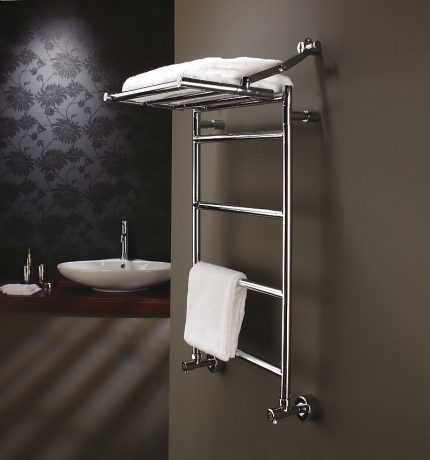
Do not start operating electrical heated towel rails:
- before the end of the installation on the wall;
- disassembled;
- in rooms with damaged wiring;
- when connected to an ungrounded outlet.
Wipe the case before turning it on for the first time. heated towel rail with a damp cloth, remove building dust, grease stains, wait for the surface to dry. If the instructions are read and all safety requirements are met, then you can safely turn on the electric heated towel rail to the network.
Use of electric heated towel rail
EPS can be installed not only in the bathroom or in the combined bathroom. Installation of this equipment is possible anywhere in the apartment or house. Floor portable heated towel rails. To dry things faster, the device can also be connected to the mains on the balcony or on the street.
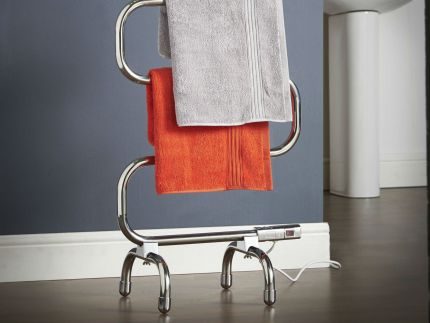
Electrical Recommendations heated towel rail:
- try to use only cross bars for drying things;
- do not place on the case EPS paper or plastic products;
- do not clean heated towel rail in the on state;
- Do not lean on the crossbeams.
Compliance with these rules will extend the life of the electric heated towel rail and protect it from damage. But if the equipment is still out of order, do not rush to call the master - you can deal with the breakdown yourself. And how to do it you can read here.
Quick photo guide for home installers
A selection of photos will clearly demonstrate the stages of installation and connection of electric drying:
The connection is complete, now it remains to fix the electric dryer on the wall, for this:
There is nothing particularly complicated in installing and connecting an electric dryer. You can cope with the installation yourself, without calling an electrician. However, an assistant will still be required to hold the device.
Important installation and construction information EPS
Electrical installation heated towel rail It does not require a specialized tool: a grinder, a welding machine, a soldering iron. To install it, a screwdriver and a drill are enough, which, in extreme cases, can be asked from a neighbor.
Therefore mount EPS Any person who has the basic skills of working with a drill can carry out a repaired wall.
Electric heated towel rails do not require special communications if there is a rule-mounted nearby power outlet. Wall constructions on some models allow you to rotate the frame EPS to save space in the bathroom.
Maximum working surface temperature for most heated towel rails limited to 70 ° C, which is enough to heat a small room in the cold season.
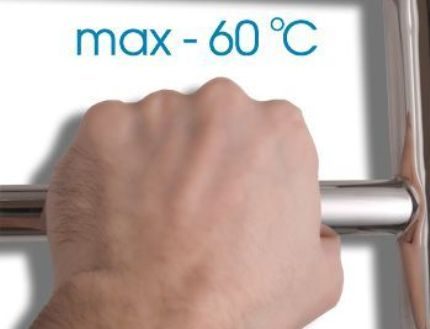
Models EPShaving oil in the form of a heat carrier are demanding on the level of inclination of the transverse slats. Therefore this type EPS it is recommended to install on a horizontal level and strictly adhere to the bottom location TENA, according to instructions.
Conclusions and useful video on the topic
Hidden connection EPS:
Installation on a tiled plasterboard wall:
Step-by-step instruction in pictures:
Following the above installation instructions will help any homeowner install electrical heated towel rail by yourself. Tips will help to avoid cracks in ceramic tiles, keep drills working and protect your family from accidents and injuries.
Perhaps you already had to deal with the installation of a heated towel rail and you can give valuable advice to our readers? Please share your experience, ask questions in the block below. You can supplement your comments with photos.

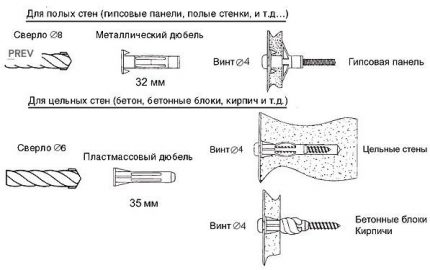
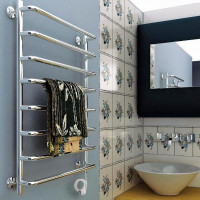 Repairing an electric heated towel rail: an overview of popular breakdowns and how to fix them
Repairing an electric heated towel rail: an overview of popular breakdowns and how to fix them 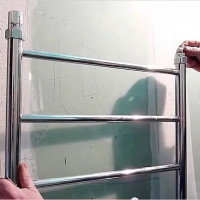 Transfer the heated towel rail to another wall in the bathroom: installation instructions
Transfer the heated towel rail to another wall in the bathroom: installation instructions 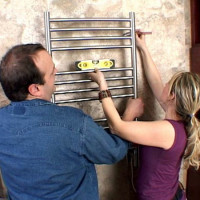 Installing a heated towel rail in the bathroom: DIY installation guide
Installing a heated towel rail in the bathroom: DIY installation guide 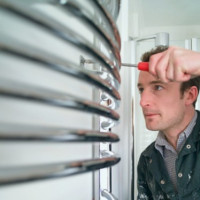 How to replace a heated towel rail in a bathroom according to the rules
How to replace a heated towel rail in a bathroom according to the rules 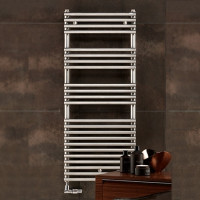 How to choose a heated towel rail for the bathroom: what to look at before buying + an overview of popular brands
How to choose a heated towel rail for the bathroom: what to look at before buying + an overview of popular brands 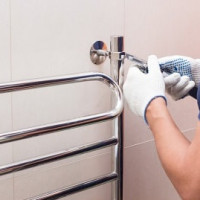 How to connect a heated towel rail to the DHW riser and a heating circuit with your own hands
How to connect a heated towel rail to the DHW riser and a heating circuit with your own hands  How much does it cost to connect gas to a private house: the price of organizing gas supply
How much does it cost to connect gas to a private house: the price of organizing gas supply  The best washing machines with dryer: model rating and customer tips
The best washing machines with dryer: model rating and customer tips  What is the color temperature of light and the nuances of choosing the temperature of the lamps to suit your needs
What is the color temperature of light and the nuances of choosing the temperature of the lamps to suit your needs  Replacement of a geyser in an apartment: replacement paperwork + basic norms and requirements
Replacement of a geyser in an apartment: replacement paperwork + basic norms and requirements
In the old apartment we had a heated towel rail, and when we moved to a new one, it was not in the bathroom. I had to buy an electric one, because without it it’s uncomfortable and cool. It turned out that there are heated towel rails with a cable inside, and there are filled with oil. I liked the oil-filled, but there you need to install it strictly according to the instructions. What are the advantages of such an electrical appliance: in addition to electricity, it doesn’t need anything and it turned out to be simpler to connect, it doesn’t need to be cut into any communications additionally, but it’s really more convenient to do together, it will work out smoother. Well, of course, I would recommend unplugging it from the outlet for the duration of the absence.
Interestingly, for the first time I hear about electric heated towel rails. I think that for me it would be much more convenient than the current water heated towel rails, which are cold for half the winter due to some problems of the Housing Office, and in the summer it happens that they turn off the hot water from which they work. And for someone they are also tied to heating, not hot water, then in general they do not work all summer. The only thing is that you will have to pay extra for electricity, but it seems to me it's worth it.
Tell me, does an electric heated towel rail have to be equipped with a switch? We have a developer put in the SU model in which for some reason there is no switch ... I suspect that this should not be. How and by what is it standardized according to the rules of electrical safety and fire safety?
Hello. In fact, all modern models of electric heated towel rails are equipped with switches. True, sometimes the switch on the PS is positioned in such a way that it is rather difficult to notice it.
If you still have a PS model installed that does not have a switch, then this is easy to fix yourself, there are several options for solving this issue:
- differential switch, aka RCD;
- inset of a small switch with backlight (photo attached);
- connect the heated towel rail through a Wi-Fi outlet.
The latter option is quite practical, since you can control the PS from anywhere.
You have a connection without grounding in the photo, only two power. Has anyone yet shunned? I have the same story, the house is old, the electrician is old, but copper, without grounding. Separately grounding was thrown to the washer from the machine on the riser, but now I doubt about ps. And all the tiles have already been laid ..